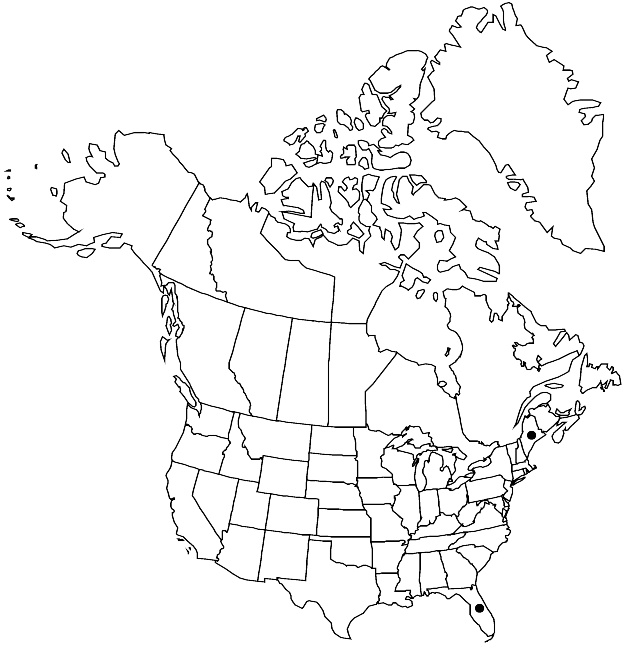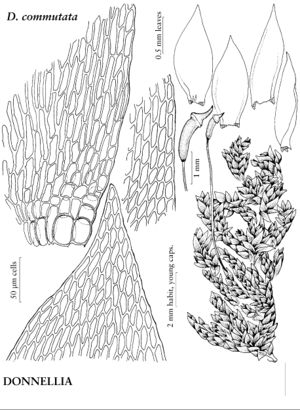Difference between revisions of "Donnellia commutata"
Bryologist 91: 134. 1988.
FNA>Volume Importer |
FNA>Volume Importer |
||
| Line 9: | Line 9: | ||
|special_status={{Treatment/ID/Special_status | |special_status={{Treatment/ID/Special_status | ||
|code=F | |code=F | ||
| − | |label= | + | |label=Illustrated |
}} | }} | ||
|basionyms={{Treatment/ID/Basionym | |basionyms={{Treatment/ID/Basionym | ||
|name=Neckera commutata | |name=Neckera commutata | ||
|authority=Müller Hal. | |authority=Müller Hal. | ||
| + | |rank=species | ||
|publication_title=Bot. Zeitung (Berlin) | |publication_title=Bot. Zeitung (Berlin) | ||
|publication_place=15: 385. 1857 | |publication_place=15: 385. 1857 | ||
| Line 20: | Line 21: | ||
|name=Fabronia donnellii | |name=Fabronia donnellii | ||
|authority=Austin | |authority=Austin | ||
| + | |rank=species | ||
}} {{Treatment/ID/Synonym | }} {{Treatment/ID/Synonym | ||
|name=Meiotheciopsis commutata | |name=Meiotheciopsis commutata | ||
|authority=(Müller Hal.) W. R. Buck | |authority=(Müller Hal.) W. R. Buck | ||
| + | |rank=species | ||
}} {{Treatment/ID/Synonym | }} {{Treatment/ID/Synonym | ||
|name=Meiothecium tenerum | |name=Meiothecium tenerum | ||
|authority=Mitten | |authority=Mitten | ||
| + | |rank=species | ||
}} | }} | ||
|hierarchy=Sematophyllaceae;Donnellia;Donnellia commutata | |hierarchy=Sematophyllaceae;Donnellia;Donnellia commutata | ||
| Line 50: | Line 54: | ||
-->{{#Taxon: | -->{{#Taxon: | ||
name=Donnellia commutata | name=Donnellia commutata | ||
| − | |||
|authority=(Müller Hal.) W. R. Buck | |authority=(Müller Hal.) W. R. Buck | ||
|rank=species | |rank=species | ||
| Line 64: | Line 67: | ||
|publication title=Bryologist | |publication title=Bryologist | ||
|publication year=1988 | |publication year=1988 | ||
| − | |special status= | + | |special status=Illustrated |
| − | |source xml=https://jpend@bitbucket.org/aafc-mbb/fna-data-curation.git/src/ | + | |source xml=https://jpend@bitbucket.org/aafc-mbb/fna-data-curation.git/src/f50eec43f223ca0e34566be0b046453a0960e173/coarse_grained_fna_xml/V28/V28_902.xml |
|genus=Donnellia | |genus=Donnellia | ||
|species=Donnellia commutata | |species=Donnellia commutata | ||
Revision as of 21:18, 16 December 2019
Stems with branches ascending. Leaves slightly concave, 0.6–1.1 × 0.2–0.4 mm; alar cells short-oblong, yellow, supra-alar cells quadrate, not inflated, unpigmented; distal laminal cells long-rhomboidal to long-hexagonal, walls thick. Capsule 0.7–1.2 mm, slightly or not contracted below mouth; annulus absent; peristome bone white when dry, ± translucent when moist; exostome teeth external surface with straight median line, not furrowed, not cross striolate, lamellae conspicuous, internal surface scarcely projecting; endostome fragile, basal membrane very low or absent, appearing absent in deoperculate capsules, segments linear, almost as long as exostome teeth, ± keeled, not perforate, finely papillose, sometimes fugacious, cilia absent. Spores 25–27 µm.
Phenology: Capsules mature winter.
Habitat: White sand evergreen oak scrub forests, trunks and large branches (including canopy) of Quercus
Elevation: low elevations
Distribution

Fla., Mexico, West Indies, Central America, South America.
Discussion
Donnellia commutata is common in oak scrub of north central Florida, but has been mostly overlooked because of its sympatry with and morphological similarity to Sematophyllum adnatum, one of the great weedy mosses. Donnellia commutata may be distinguished satisfactorily only when fertile by its shorter setae, white peristome (when dry), and rather smooth exostome teeth. The endostome often appears absent because the segments break off shortly after the loss of the operculum. However, the endostome can be easily demonstrated by the dissection of mature, operculate capsules.
Selected References
None.
